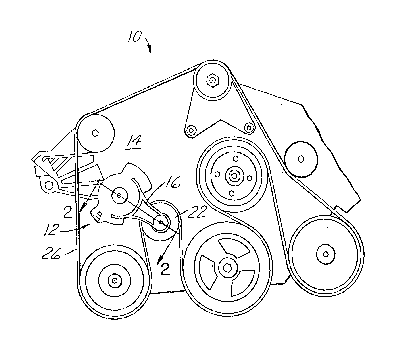Une partie des informations de ce site Web a été fournie par des sources externes. Le gouvernement du Canada n'assume aucune responsabilité concernant la précision, l'actualité ou la fiabilité des informations fournies par les sources externes. Les utilisateurs qui désirent employer cette information devraient consulter directement la source des informations. Le contenu fourni par les sources externes n'est pas assujetti aux exigences sur les langues officielles, la protection des renseignements personnels et l'accessibilité.
L'apparition de différences dans le texte et l'image des Revendications et de l'Abrégé dépend du moment auquel le document est publié. Les textes des Revendications et de l'Abrégé sont affichés :
| (12) Brevet: | (11) CA 2094655 |
|---|---|
| (54) Titre français: | TENDEUR AUXILIAIRE DE COURROIE D'ENTRAINEMENT D'UN MOTEUR D'AUTOMOBILE |
| (54) Titre anglais: | AUTOMOTIVE ACCESSORY DRIVE BELT TENSIONER |
| Statut: | Périmé et au-delà du délai pour l’annulation |
| (51) Classification internationale des brevets (CIB): |
|
|---|---|
| (72) Inventeurs : |
|
| (73) Titulaires : |
|
| (71) Demandeurs : |
|
| (74) Agent: | MARKS & CLERK |
| (74) Co-agent: | |
| (45) Délivré: | 2000-05-23 |
| (22) Date de dépôt: | 1993-04-22 |
| (41) Mise à la disponibilité du public: | 1993-10-30 |
| Requête d'examen: | 1997-02-12 |
| Licence disponible: | S.O. |
| Cédé au domaine public: | S.O. |
| (25) Langue des documents déposés: | Anglais |
| Traité de coopération en matière de brevets (PCT): | Non |
|---|
| (30) Données de priorité de la demande: | ||||||
|---|---|---|---|---|---|---|
|
An arm assembly for an automotive engine accessory
drive belt tensioner has a wound spring which is
permanently captured upon the arm by a retainer which is
effective not only prior to installation of the arm upon
an engine, but also after the installation and removal of
the arm from an engine.
Note : Les revendications sont présentées dans la langue officielle dans laquelle elles ont été soumises.
Note : Les descriptions sont présentées dans la langue officielle dans laquelle elles ont été soumises.

2024-08-01 : Dans le cadre de la transition vers les Brevets de nouvelle génération (BNG), la base de données sur les brevets canadiens (BDBC) contient désormais un Historique d'événement plus détaillé, qui reproduit le Journal des événements de notre nouvelle solution interne.
Veuillez noter que les événements débutant par « Inactive : » se réfèrent à des événements qui ne sont plus utilisés dans notre nouvelle solution interne.
Pour une meilleure compréhension de l'état de la demande ou brevet qui figure sur cette page, la rubrique Mise en garde , et les descriptions de Brevet , Historique d'événement , Taxes périodiques et Historique des paiements devraient être consultées.
| Description | Date |
|---|---|
| Inactive : CIB de MCD | 2006-03-11 |
| Inactive : CIB de MCD | 2006-03-11 |
| Le délai pour l'annulation est expiré | 2003-04-22 |
| Lettre envoyée | 2002-04-22 |
| Accordé par délivrance | 2000-05-23 |
| Inactive : Page couverture publiée | 2000-05-22 |
| Inactive : Taxe finale reçue | 2000-02-11 |
| Préoctroi | 2000-02-11 |
| Lettre envoyée | 1999-08-25 |
| Un avis d'acceptation est envoyé | 1999-08-25 |
| Un avis d'acceptation est envoyé | 1999-08-25 |
| Inactive : Approuvée aux fins d'acceptation (AFA) | 1999-08-03 |
| Modification reçue - modification volontaire | 1997-08-29 |
| Inactive : Renseign. sur l'état - Complets dès date d'ent. journ. | 1997-07-25 |
| Inactive : Dem. traitée sur TS dès date d'ent. journal | 1997-07-25 |
| Toutes les exigences pour l'examen - jugée conforme | 1997-02-12 |
| Exigences pour une requête d'examen - jugée conforme | 1997-02-12 |
| Demande publiée (accessible au public) | 1993-10-30 |
Il n'y a pas d'historique d'abandonnement
Le dernier paiement a été reçu le 2000-03-10
Avis : Si le paiement en totalité n'a pas été reçu au plus tard à la date indiquée, une taxe supplémentaire peut être imposée, soit une des taxes suivantes :
Veuillez vous référer à la page web des taxes sur les brevets de l'OPIC pour voir tous les montants actuels des taxes.
| Type de taxes | Anniversaire | Échéance | Date payée |
|---|---|---|---|
| Requête d'examen - générale | 1997-02-12 | ||
| TM (demande, 5e anniv.) - générale | 05 | 1998-04-22 | 1998-03-18 |
| TM (demande, 6e anniv.) - générale | 06 | 1999-04-22 | 1999-04-12 |
| Taxe finale - générale | 2000-02-11 | ||
| TM (demande, 7e anniv.) - générale | 07 | 2000-04-24 | 2000-03-10 |
| TM (brevet, 8e anniv.) - générale | 2001-04-23 | 2001-03-19 |
Les titulaires actuels et antérieures au dossier sont affichés en ordre alphabétique.
| Titulaires actuels au dossier |
|---|
| FORD MOTOR COMPANY OF CANADA, LIMITED |
| Titulaires antérieures au dossier |
|---|
| RICHARD J. MECKSTROTH |
| ROBERT, II REBANDT |
| THOMAS R. LAHVIC |
| THOMAS S. BUSHMAN |
| TIMOTHY T. VAUGHN |